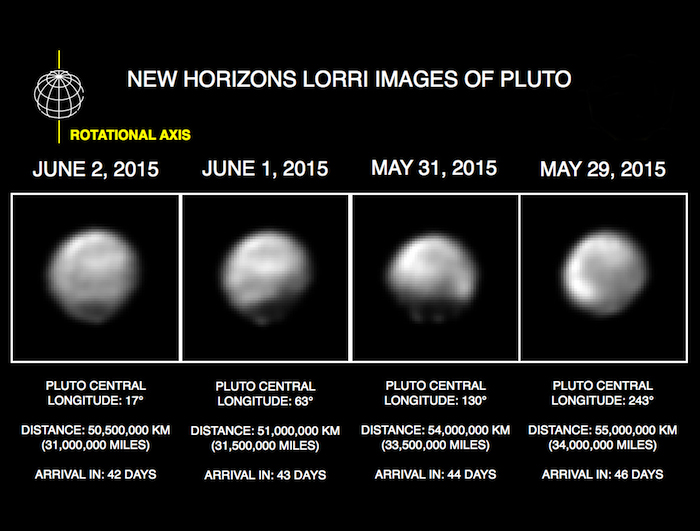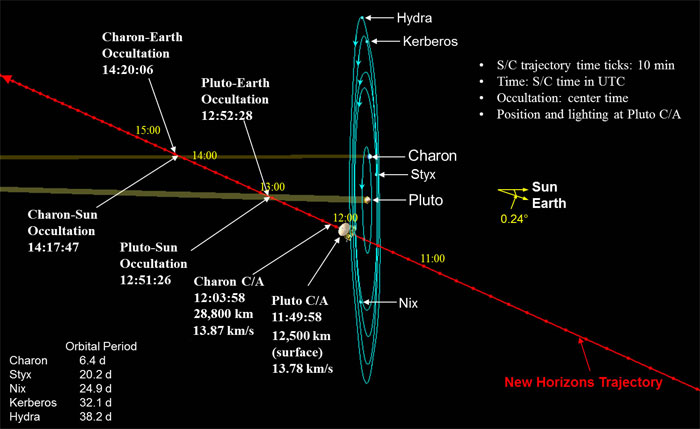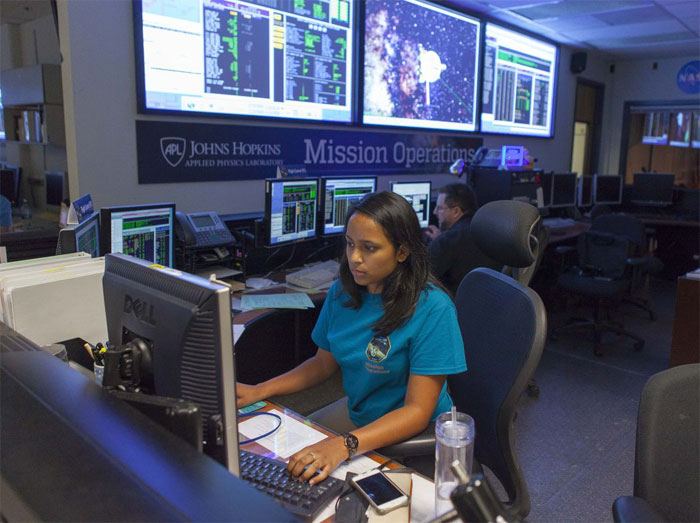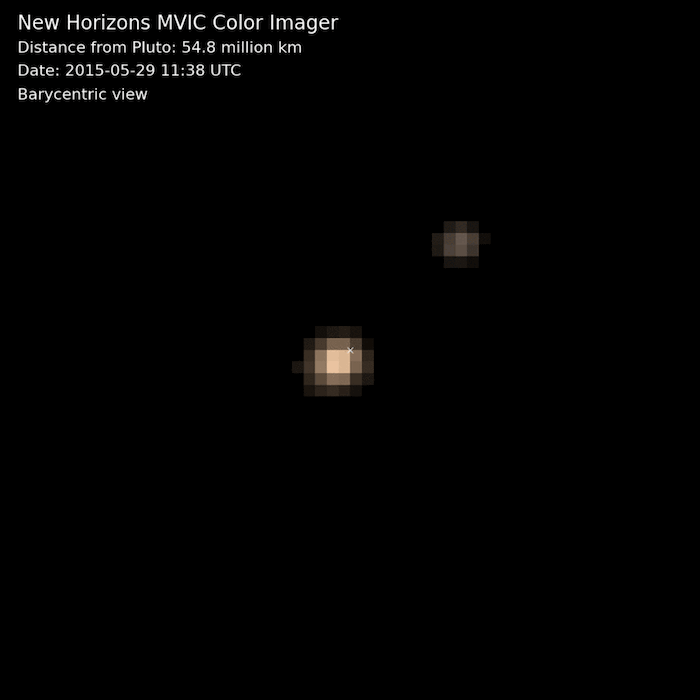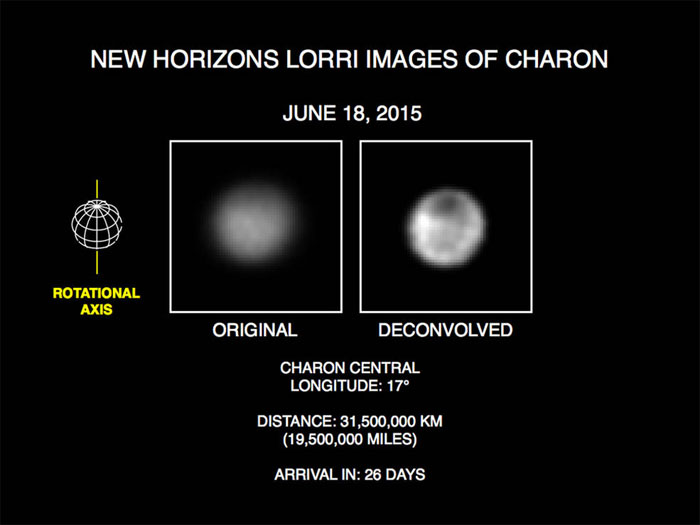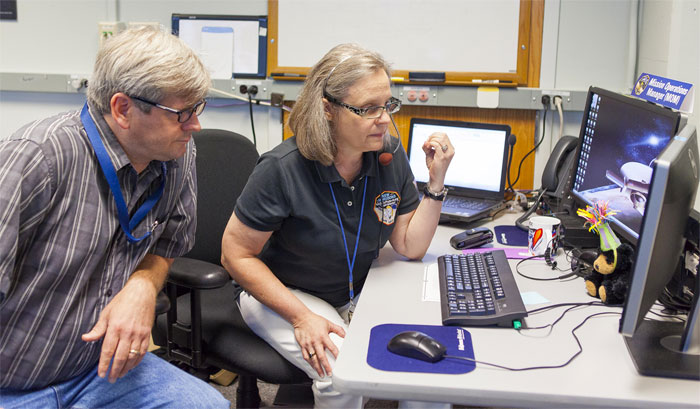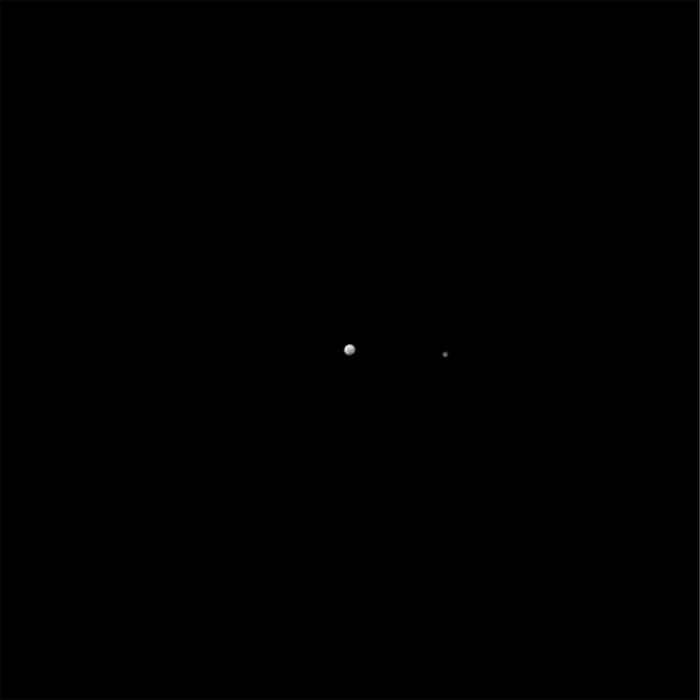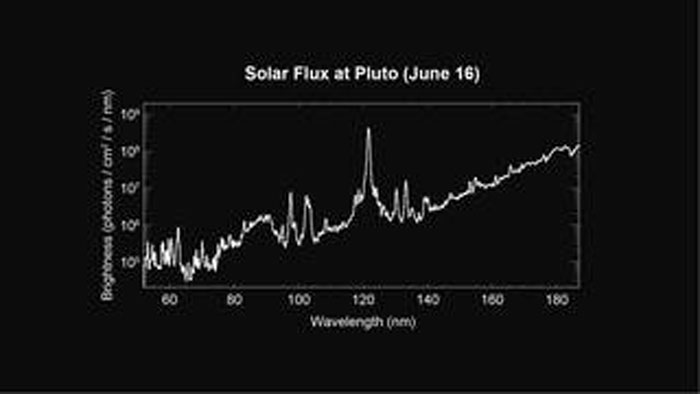Although the two movies were prepared from the same images, they display the Pluto-Charon pair from different perspectives. One movie is “Pluto-centric”, meaning that Charon is shown as it moves in relation to Pluto, which is digitally centered in the movie. (The North Pole of Pluto is at the top.) Pluto makes one turn around its axis every 6 days, 9 hours and 17.6 minutes—the same amount of time that Charon rotates in its orbit. Looking closely at the images in this movie, one can detect a regular shift in Pluto’s brightness—due to the brighter and darker terrains on its differing faces.
The second movie is barycentric, meaning that both Pluto and Charon are shown in motion around the binary’s barycenter – the shared center of gravity between the two bodies as they do a planetary jig. Because Pluto is much more massive than Charon, the barycenter (marked by a small “x” in the movie) is much closer to Pluto than to Charon.
As New Horizons closes in its intended target, the best is yet to come. “Color observations are going to get much, much better, eventually resolving the surfaces of Charon and Pluto at scales of just kilometers,” said Cathy Olkin, New Horizons deputy project scientist from SwRI. “This will help us unravel the nature of their surfaces and the way volatiles transport around their surfaces. I can’t wait; it’s just a few weeks away!”
The Johns Hopkins University Applied Physics Laboratory (APL) manages the New Horizons mission for NASA’s Science Mission Directorate in Washington. Alan Stern of the Southwest Research Institute (SwRI), headquartered in San Antonio, is the principal investigator and leads the mission. SwRI leads the science team, payload operations, and encounter science planning. New Horizons is part of the New Frontiers program, managed by NASA’s Marshall Space Flight Center in Huntsville, Alabama. APL designed, built and operates the spacecraft.
Ralph is a joint project between SwRI, Ball Aerospace in Boulder, Colorado, and NASA’s Goddard Space Flight Center, Greenbelt, Maryland.
Quelle: NASA
-
Update: 23.06.2015
.
NASA's New Horizons Probe Gives Us Our First Look at the 'Person in Pluto'
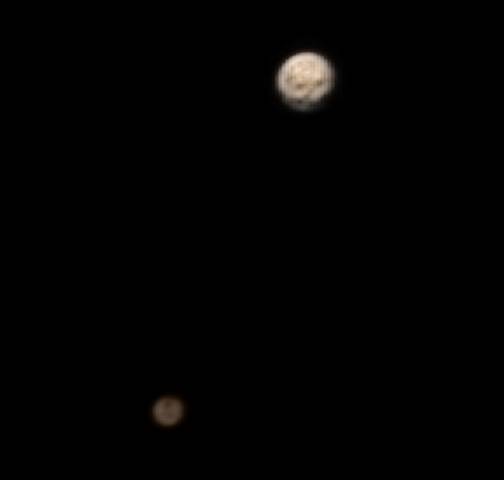
A combination of imagery from the LORRI and MVIC imagers on NASA's New Horizons probe provides a colorized view of Pluto (top) and its largest moon, Charon (bottom). NASA / JHUAPL / SwRI / Ian Regan
Humanity has looked up to the "Man in the Moon" for millennia, but this could be one of our first views of the "Person in Pluto."
The views are getting better and better as NASA's New Horizons spacecraft approaches Pluto for its July 14 flyby — and the pictures have begun revealing surface details. Ian Regan, an image-processing enthusiast from Plymouth, England, combined four images from New Horizons' Long Range Reconnaissance Imager with color data from the probe's Multispectral Visible Imaging Camera to produce an eerie colorized view of Pluto and its biggest moon, Charon.
The picture's orientation makes Pluto look as if it's a big-headed alien skull from a "Star Trek" episode, with two cratered eyes looking out toward the camera. It's a subtle effect, reminiscent of the Viking 1 orbiter's eerie "Face on Mars" image from 1976. Like that image of Mars' Cydonia region, a closer view can easily spoil the effect — so enjoy the Person in Pluto while you can.
Quelle: NBC-News
---
New from NASA's New Horizons: Increasing Variety on Pluto's Close Approach Hemisphere, and a 'Dark Pole' on Charon
NASA’s New Horizons spacecraft doesn’t pass Pluto until July 14 – but the mission team is making new discoveries as the piano-sized probe bears down on the Pluto system.
In a long series of images obtained by New Horizons’ telescopic Long Range Reconnaissance Imager (LORRI) May 29-June 19, Pluto and its largest moon, Charon, appear to more than double in size. From this rapidly improving imagery, scientists on the New Horizons team have found that the “close approach hemisphere” on Pluto that New Horizons will fly over has the greatest variety of terrain types seen on the planet so far. They have also discovered that Charon has a “dark pole” – a mysterious dark region that forms a kind of anti-polar cap.
"This system is just amazing," said Alan Stern, New Horizons Principal Investigator, from the Southwest Research Institute, Boulder, Colorado. "The science team is just ecstatic with what we see on Pluto’s close approach hemisphere: Every terrain type we see on the planet—including both the brightest and darkest surface areas —are represented there, it’s a wonderland!
"And about Charon—wow—I don’t think anyone expected Charon to reveal a mystery like dark terrains at its pole," he continued. "Who ordered that?"
.
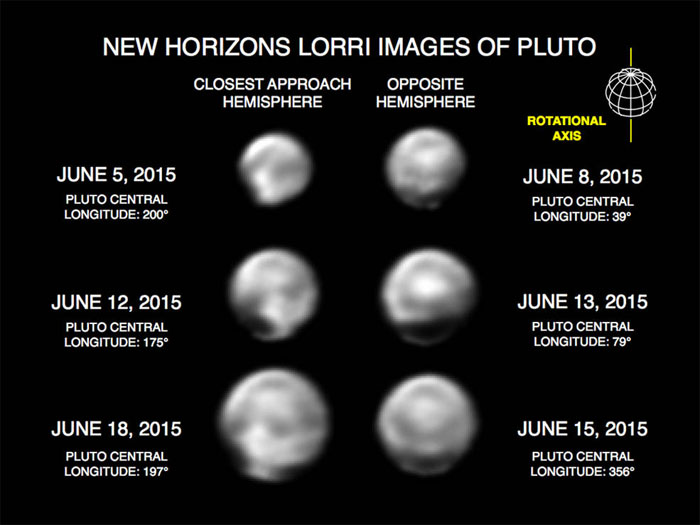
These images, taken by New Horizons' Long Range Reconnaissance Imager (LORRI), show numerous large-scale features on Pluto's surface. When various large, dark and bright regions appear near limbs, they give Pluto a distinct, but false, non-spherical appearance. Pluto is known to be almost perfectly spherical from previous data. These images are displayed at four times the native LORRI image size, and have been processed using a method called deconvolution, which sharpens the original images to enhance features on Pluto.
Credits: NASA/Johns Hopkins University Applied Physics Laboratory/Southwest Research Institute
.
New Horizons scientists use a technique called deconvolution to sharpen the raw, unprocessed pictures that the spacecraft beams back to Earth; the contrast in these latest images has also been stretched to bring out additional details. Deconvolution can occasionally produce artifacts, so the team will be carefully reviewing newer images taken from closer range to determine whether some of the tantalizing details seen in these images persist. Pluto’s non-spherical appearance in these images is not real; it results from a combination of the image-processing technique and Pluto’s large variations in surface brightness.
"The unambiguous detection of bright and dark terrain units on both Pluto and Charon indicates a wide range of diverse landscapes across the pair," said science team co-investigator and imaging lead Jeff Moore, of NASA Ames Research Center, Mountain View, California. “For example, the bright fringe we see on Pluto may represent frost deposited from an evaporating polar cap, which is now in summer sun.”
.
These recent images show the discovery of significant surface details on Pluto’s largest moon, Charon. They were taken by the New Horizons Long Range Reconnaissance Imager (LORRI) on June 18, 2015. The image on the left is the original image, displayed at four times the native LORRI image size. After applying a technique that sharpens an image called deconvolution, details become visible on Charon, including a distinct dark pole. Deconvolution can occasionally introduce "false" details, so the finest details in these pictures will need to be confirmed by images taken from closer range in the next few weeks.
Credits: NASA/Johns Hopkins University Applied Physics Laboratory/Southwest Research Institute
.
New Horizons is approximately 2.9 billion miles (4.7 billion kilometers) from Earth and just 16 million miles (25 million kilometers) from Pluto. The spacecraft and payload are in good health and operating normally.
Quelle: NASA
.
Update: 25.06.2015
.
SOFIA to work with New Horizons during upcoming Pluto encounter

NASA’s high-flying infrared observatory is Down Under this week to observe the southern sky, and to make a unique observation ahead of New Horizons' historic encounter with Pluto and its moons next month. The aircraft is an unusual airborne observatory known as SOFIA, or the Stratospheric Observatory For Infrared Astronomy. SOFIA began observations in 2010, and consists of a 2.5-meter telescope mounted aboard a modified Boeing 747SP wide-body aircraft. In addition to numerous southern sky targets, astronomers hope to catch a rare occultation of a +12th magnitude star by the planet Pluto on June 29. Observers will utilize the High Speed Imaging Photometer for Occultations (HIPO) and the Focal Plane Imager (FPI) to record the brief, seconds-long event. “SOFIA’s 2013 deployment to New Zealand and the resulting observations were of great scientific value,” SOFIA program manager Eddie Zavala said in a recent press release. “Our research staff and guest investigators have been looking forward to building on that success with our return to the Southern Hemisphere this month.” This occultation gives astronomers a chance to measure the atmosphere of Pluto and its composition just before New Horizons' July 14 encounter. New Horizons will also pass through the shadows of Pluto and Charon and witness two radio occultations—think of it as the most distant solar eclipses ever recorded—for comparison. And you never know what other types of serendipitous discoveries might result. A similar occultation of a background star by Uranus was witnessed by SOFIA’s predecessor the Kuiper Airborne Observatory in 1977. This event revealed the ring system of Uranus, as the star's light dimmed two times more than expected as the planet passed in front of it.
Quelle: SEN
.
Update: 27.06.2015
.
What Is Glittering at Pluto’s North Pole?
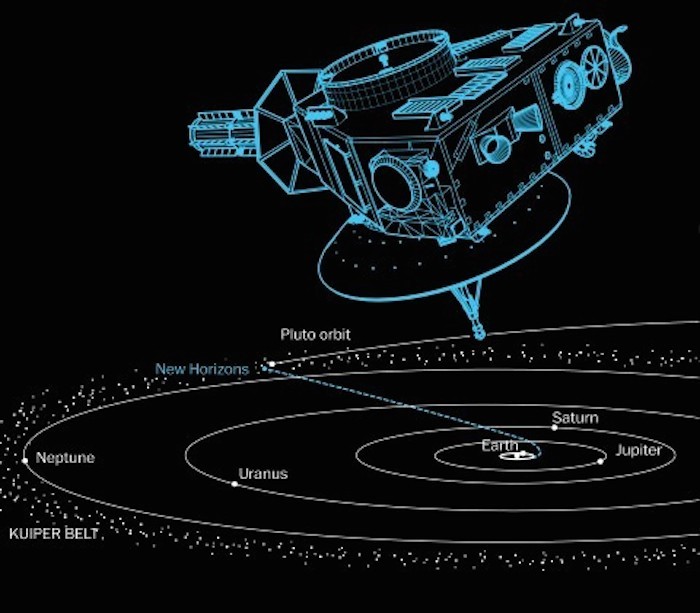
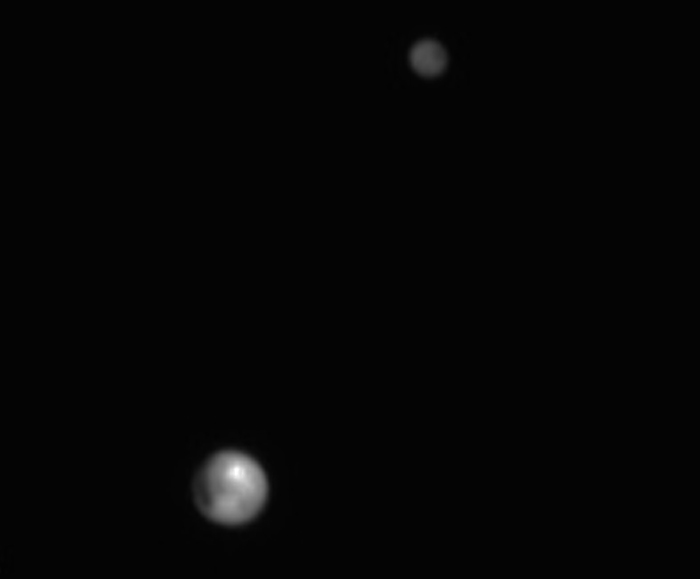
Pluto and Charon are getting clearer every day.
Photo by NASA/JHUAPL/SwRI
As the New Horizons spacecraft nears Pluto, more details are coming into view, and we are beginning to see surface features on the tiny world.
And that means we’ll see things that are … odd. Perhaps “as yet unexplained” is a better term, since we’re seeing these markings for the first time in human history. The press releases have been amazing, but the images released have been enlarged and processed in complex ways to bring out details.
But as the probe gets closer, we can see details without such means. The raw data are posted online within hours of them being transmitted back to Earth, and that means they are available for perusal.
I was looking at a pair of fresh ones taken just today, June 25, at 05:37 UTC (just after midnight, more or less, U.S. time), when New Horizons was just 22.9 million kilometers from Pluto. They’re amazing. Both Pluto and its large moon Charon show all kinds of features, as you can see at the top of this article (the only processing I did was a straight enlargement and a brightness/contrast fiddle). Overall, Charon is much darker than Pluto, but even then surface features are clearly visible.
But that bright spot on Pluto surprised me. That’s near its north pole, and it’s been seen before in earlier images, basically as a splotch. In this image it’s quite obvious.
I wondered if perhaps this was an image artifact, like a particle hit on the detector, but in fact it’s the same in the other image taken 30 seconds earlier. Here are the two shots side by side:
.
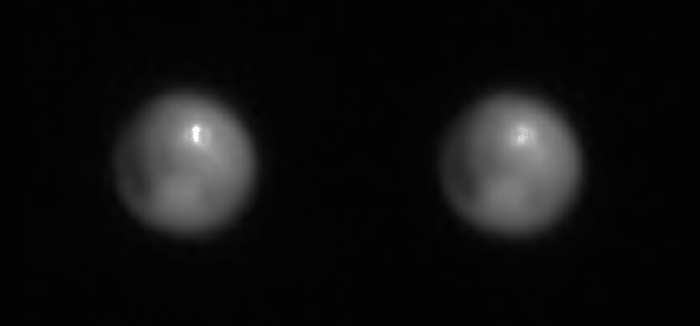
Pictures of Pluto taken at 05:37:30 (left) and 30 seconds earlier (right), enlarged and contrast enhanced.
Photo by NASA/JHUAPL/SwRI
The spot is very small, probably on the same scale as a single pixel or two in New Horizon’s long-range camera. That means a slight change in the pointing can make its shape look different. Remember too this image is enlarged by a factor of about 10, which can play with the shape as well. While the shape you see may not be real, the brightness contrast is.
But the important thing to note is that it’s seen in both pictures. I’ll note too that Pluto was in a different spot in the camera’s field of view, too, so this isn’t some bad lone pixel either, messing with the shot. This bright spot is quite real. Measuring the pixel brightnesses, it looks to be about twice as bright as the surface around it.
Right now, Pluto is only a couple of dozen pixels across in the long-range camera’s view. New Horizons is moving so rapidly that in 10 days Pluto will be twice this size, and will double again five days after that. Features that are tantalizingly fuzzy now will continue to sharpen, and then we’ll see Pluto as it truly is.
Is this spot at the north pole a fresh impact? Is it nitrogen in its atmosphere freezing out as Pluto slowly moves away from the Sun on its elliptical orbit? Is it one big spot or a lot of little ones (like the weird ones we see on Ceres)?
Give it a couple of weeks. Because that's how close we are. After more than nine years and 5 billion kilometers of travel, New Horizons is about to give us quite a show.
Quelle: Bad Astronomy
.
Update: 1.07.2015
.
New Horizons ‘Speeds Up’ on Final Approach to Pluto
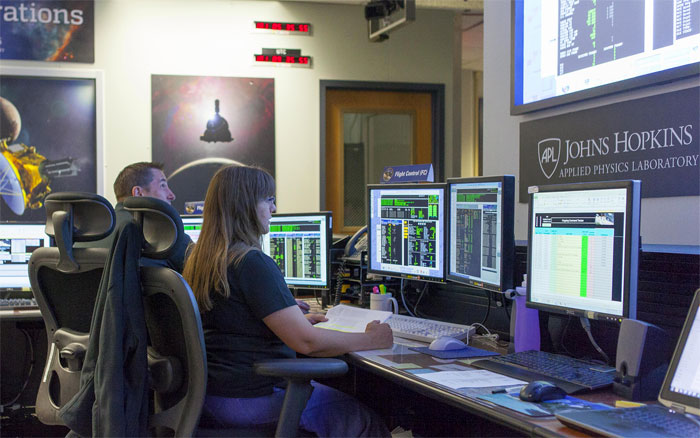
In the New Horizons Mission Operations Center at the Johns Hopkins University Applied Physics Laboratory in Laurel, Maryland, flight controllers (from left) Chris Regan and Becca Sepan monitor data from NASA’s New Horizons spacecraft on June 30, after a short course-correction maneuver refined New Horizons path toward a flyby of Pluto on July 14.
.
With just two weeks to go before its historic July 14 flight past Pluto, NASA’s New Horizons spacecraft tapped the accelerator late last night and tweaked its path toward the Pluto system.
The 23-second thruster burst was the third and final planned targeting maneuver of New Horizons’ approach phase to Pluto; it was also the smallest of the nine course corrections since New Horizons launched in January 2006. It bumped the spacecraft’s velocity by just 27 centimeters per second – about one-half mile per hour – slightly adjusting its arrival time and position at a flyby close-approach target point approximately 7,750 miles (12,500 kilometers) above Pluto’s surface.
While it may appear to be a minute adjustment for a spacecraft moving 32,500 miles per hour, the impact is significant. New Horizons Mission Design Lead Yanping Guo, of the Johns Hopkins Applied Physics Laboratory in Laurel, Maryland, says without the adjustment, New Horizons would have arrived 20 seconds late and 114 miles (184 kilometers) off-target from the spot where it will measure the properties of Pluto’s atmosphere. Those measurements depend on radio signals being sent from Earth to New Horizons at precise times as the spacecraft flies through the shadows of Pluto and Pluto’s largest moon, Charon.
In fact, timing and accuracy are critical for all New Horizons flyby observations, since those commands are stored in the spacecraft’s computers and programmed to “execute” at exact times.
This latest shift was based on radio-tracking data on the spacecraft and range-to-Pluto measurements made by optical-navigation imaging of the Pluto system taken by New Horizons in recent weeks. Using commands transmitted to the spacecraft on June 28, the thrusters began firing at 11:01 p.m. EDT on June 29 and stopped 23 seconds later. Telemetry indicating the spacecraft was healthy and that the maneuver went as designed began reaching the New Horizons Mission Operations Center at APL, through NASA’s Deep Space Network at 5:30 a.m. EDT on June 30.
“We are really on the final path,” said New Horizons Project Manager Glen Fountain, of APL. “It just gets better and more exciting every day.”
“This maneuver was perfectly performed by the spacecraft and its operations team,” added mission principal investigator Alan Stern, of Southwest Research Institute, Boulder, Colorado. “Now we’re set to fly right down the middle of the optimal approach corridor.”
New Horizons is now about 10 million miles (16 million kilometers) from the Pluto system – some 2.95 billion miles (4.75 billion kilometers) from Earth.
.
In the New Horizons Mission Operations Center at the Johns Hopkins University Applied Physics Laboratory in Laurel, Maryland, Mission Operations Manager Alice Bowman and operations team member Karl Whittenburg watch for data confirming that the Pluto-bound NASA spacecraft successfully executed a course correction maneuver on June 30.
Quelle: NASA
-
New Horizons Update: Methane Detected; New Images of Pluto and Charon; Sunrise/Sunset Observations
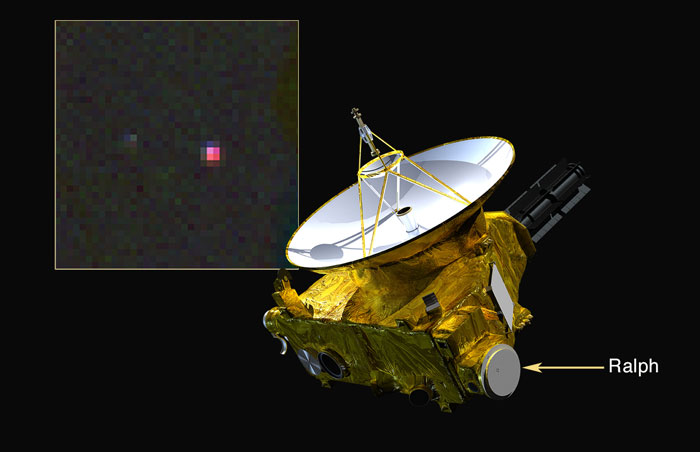
The location of the New Horizons Ralph instrument, which detected methane on Pluto, is shown. The inset is a false color image of Pluto and Charon in infrared light; pink indicates methane on Pluto’s surface.
Credits: Photo credit: NASA/Johns Hopkins Applied Physics Laboratory/Southwest Research Institute
-
Yes, there is methane on Pluto, and, no, it doesn’t come from cows. The infrared spectrometer on NASA’s Pluto-bound New Horizons spacecraft has detected frozen methane on Pluto’s surface; Earth-based astronomers first observed the chemical compound on Pluto in 1976.
“We already knew there was methane on Pluto, but these are our first detections,” said Will Grundy, the New Horizons Surface Composition team leader with the Lowell Observatory in Flagstaff, Arizona. “Soon we will know if there are differences in the presence of methane ice from one part of Pluto to another.”
Methane (chemical formula CH4) is an odorless, colorless gas that is present underground and in the atmosphere on Earth. On Pluto, methane may be primordial, inherited from the solar nebula from which the solar system formed 4.5 billion years ago. Methane was originally detected on Pluto’s surface by a team of ground-based astronomers led by New Horizons team member Dale Cruikshank, of NASA’s Ames Research Center, Mountain View, California.
Come Fly with New Horizons on its Approach to Pluto
Images from New Horizons show the view from aboard the spacecraft closes in on the Pluto system for a July 14 flyby.
This time-lapse approach movie was made from images from the Long Range Reconnaissance Imager (LORRI) camera aboard New Horizons spacecraft taken between May 28 and June 25, 2015. During that time the spacecraft distance to Pluto decreased almost threefold, from about 35 million miles to 14 million miles (56 million kilometers to 22 million kilometers). The images show Pluto and its largest moon, Charon, growing in apparent size as New Horizons closes in. As it rotates, Pluto displays a strongly contrasting surface dominated by a bright northern hemisphere, with a discontinuous band of darker material running along the equator. Charon has a dark polar region, and there are indications of brightness variations at lower latitudes.
-
“Alice” Instrument Practices for Sunset and Sunrise Observations of Pluto’s Atmosphere
The New Horizons spacecraft has made a critical observation in preparation for its upcoming observations of Pluto’s tenuous atmosphere. Just hours after its flyby of Pluto on July 14, the spacecraft will observe sunlight passing through the planet’s atmosphere, to help scientists determine the atmosphere’s composition. “It will be as if Pluto were illuminated from behind by a trillion-watt light bulb,” said Randy Gladstone, a New Horizons scientist from Southwest Research Institute, San Antonio. On June 16, New Horizons’ Alice ultraviolet imaging spectrograph successfully performed a test observation of the sun from 3.1 billion miles away (5 billion kilometers), which will be used to interpret the July 14 observations.
.
This spectrum of the Sun obtained by New Horizons’ Alice instrument on June 16, 2015, will be used to interpret the spacecraft’s upcoming observations of Pluto’s atmosphere.
Credits: Photo credit: NASA/Johns Hopkins Applied Physics Laboratory/Southwest Research Institute
New Horizons is now less than 11 million miles (18 million kilometers) from the Pluto system. The spacecraft is healthy and all systems are operating normally.
The Johns Hopkins University Applied Physics Laboratory in Laurel, Maryland, designed, built, and operates the New Horizons spacecraft, and manages the mission for NASA’s Science Mission Directorate. The Southwest Research Institute, based in San Antonio, leads the science team, payload operations and encounter science planning. New Horizons is part of the New Frontiers Program managed by NASA’s Marshall Space Flight Center in Huntsville, Alabama.
Quelle: NASA
.
Update: 2.07.2015
.
Pluto's Black Spots and Charon's Dark Pole Grow in New Horizons View

New color images from NASA's New Horizons spacecraft show two very different faces of the mysterious dwarf planet, one with a series of intriguing spots along the equator that are evenly spaced. The images combine black-and-white data from the spacecraft's Long Range Reconnaissance Imager with lower-resolution color data from the Ralph instrument. NASA / JHUAPL / SwRI
NASA's New Horizons mission is kicking off its climactic month of July with amazing views that clearly show Pluto's black spots and Charon's dark pole growing in the spacecraft's virtual windshield.
After traveling for nine years and 3 billion miles, the New Horizons probe is less than two weeks and 9.5 million miles (15.2 million kilometers) away from Pluto. Every day is bringing improvements in image size and quality. Images from the Long Range Reconnaissance Imager, or LORRI, show patterns of dark and light areas on Pluto — including that dark patch, which looks a lot like a racing stripe, and a series of spots.
"We don't know what the spots are," the mission's principal investigator, Alan Stern of the Southwest Research Institute, said in news release, "and we can't wait to find out."
In a Reddit "Ask Me Anything" chat session, New Horizons team member Amanda Zangari compared Pluto to Triton, a moon of Neptune. Researchers believe Triton was a cousin of Pluto's in the icy Kuiper Belt that happened to be captured in Neptunian orbit:
"Both Pluto and Triton have a dark equatorial region and bright poles. Among the team, we've been impressed at how much they match. Pluto's dark patch is quite different though. Triton's got geysers, plumes and cantaloupe terrain and not a lot of craters. We won't know if Pluto is like that until we get closer, but it's within the realm of possibility."
Zangari wrote that the biggest surprise was the appearance of a dark circle at one of Charon's poles:
"We all think this is hysterical, because Charon had a dark pole in the simulation we did of what the encounter would be like. It was also a surprise because Charon's rotational light curve (i.e. its pattern of light and dark) is very subtle, so while we knew Pluto was going to have dark spots, Charon very well could have been uniform."
All these features will become clearer over the next two weeks, leading up New Horizons' Pluto flyby on July 14, when the piano-sized spacecraft will come within 7,800 miles (12,500 kilometers) of the dwarf planet's surface.
In addition to the visuals, the team is getting better readings about Pluto's composition. This week, scientists announced that they have begun to detect methane on the surface.
"We already knew there was methane on Pluto, but these are our first detections," Lowell Observatory planetary scientist Will Grundy, who heads New Horizons' surface composition team, said in a NASA news release. "Soon we will know if there are differences in the presence of methane ice from one part of Pluto to another."
There'll be a steady drumbeat of pictures, videos and live events — including Pluto TV webcasts and a series of "Plutopalooza" presentations across the country. To find a Plutopalooza near you, check out the schedules from New Horizons as well as NASA's Museum Alliance and Solar Systems Ambassadors Program.
Quelle: NBC-News
---
NASA’s New Horizons Spacecraft Stays the Course to Pluto
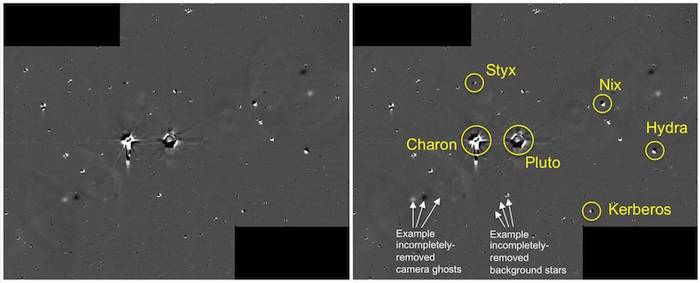
These images show the difference between two sets of 48 combined 10-second exposures with New Horizons' Long Range Reconnaissance Imager (LORRI) camera, taken at 8:40 UTC and 10:25 UTC on June 26, 2015, from a range of 21.5 million kilometers (approximately 13 million miles) to Pluto. The known small moons, Nix, Hydra, Kerberos and Styx, are visible as adjacent bright and dark pairs of dots, due to their motion in the 105 minutes between the two image sets.
Credits: NASA/JHU-APL/SwRI
NASA’s New Horizons spacecraft is getting a final “all clear” as it speeds closer to its historic July 14 flyby of Pluto and the dwarf planet’s five moons.
After seven weeks of detailed searches for dust clouds, rings, and other potential hazards, the New Horizons team has decided the spacecraft will remain on its original path through the Pluto system instead of making a late course correction to detour around any hazards. Because New Horizons is traveling at 30,800 mph (49,600 kph), a particle as small as a grain of rice could be lethal.
“We’re breathing a collective sigh of relief knowing that the way appears to be clear,” said Jim Green, director of planetary science at NASA. “The science payoff will be richer as we gather data from the optimal flight path, as opposed to having to conduct observations from one of the back-up trajectories.”
Mission scientists have been using the spacecraft’s most powerful telescopic camera, the Long Range Reconnaissance Imager (LORRI), to look for potential hazards, such as small moons, rings, or dust, since mid-May. The decision on whether to keep the spacecraft on its original course or adopt a Safe Haven by Other Trajectory, or "SHBOT" path, had to be made this week since the last opportunity to maneuver New Horizons onto an alternate trajectory is July 4.
“Not finding new moons or rings present is a bit of a scientific surprise to most of us,” said principal investigator Alan Stern of the Southwest Research Institute (SwRI) in Boulder, Colorado. “But as a result, no engine burn is needed to steer clear of potential hazards. We presented these data to NASA for review and received approval to proceed on course and plan. We are ‘go’ for the best of our planned Pluto encounter trajectories.”
New Horizons formed a hazard analysis team in 2011, after the discovery of Pluto’s fourth moon, Kerberos, raised concerns the cratering of these moons by small debris from the outer area of the solar system known as the Kuiper Belt, could spread additional hazardous debris into New Horizons’ path. Mission engineers re-tested spare spacecraft blanketing and parts back on Earth to determine how well they would stand up to particle impacts, and scientists modeled the likely formation and locations of rings and debris in the Pluto system. By the time New Horizons’ cameras were close enough to Pluto to start the search last month, the team had already estimated the chances of a catastrophic incident at far less than one percent.
The images used in the latest searches that clear
5074 Views



